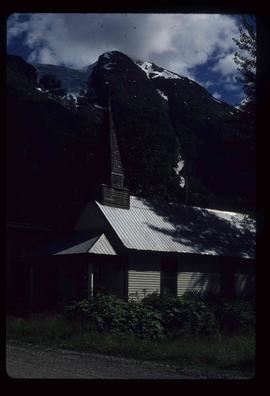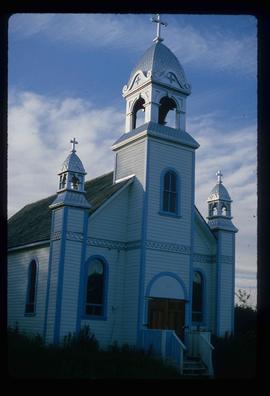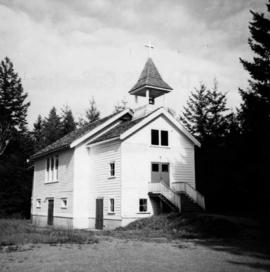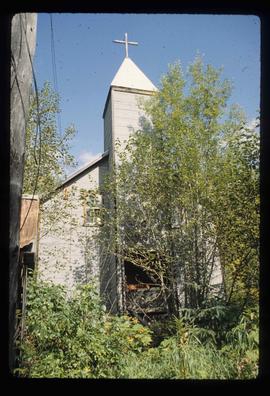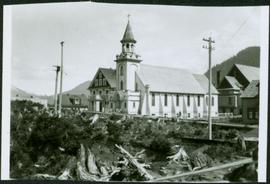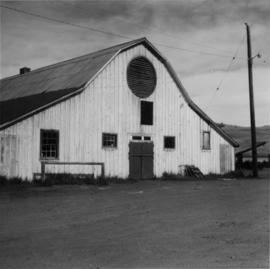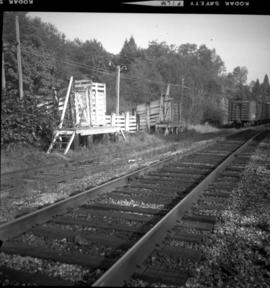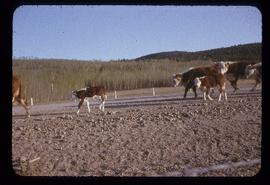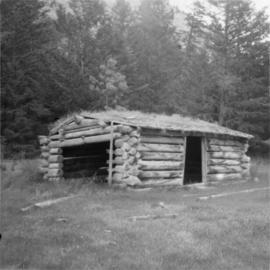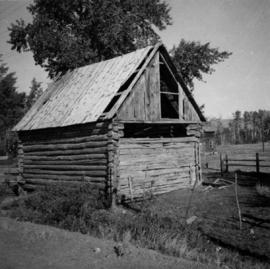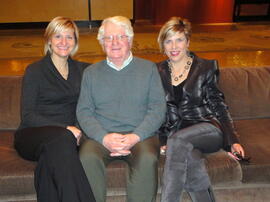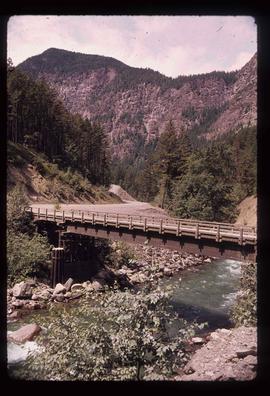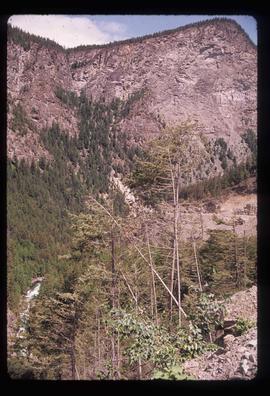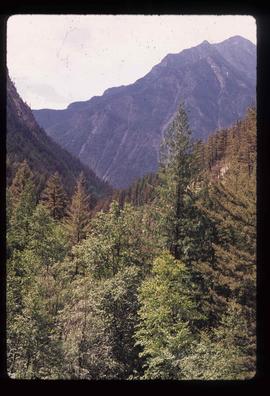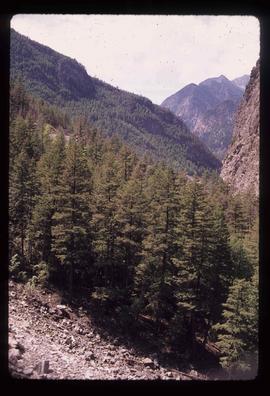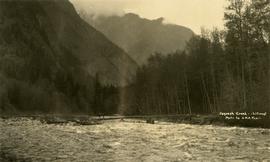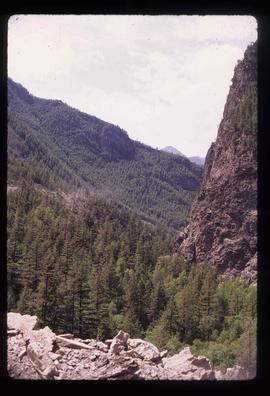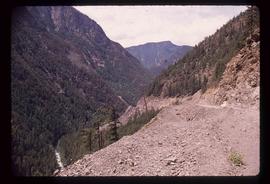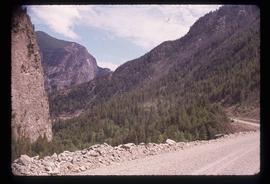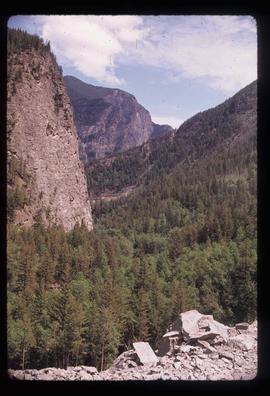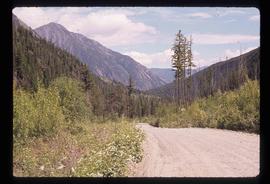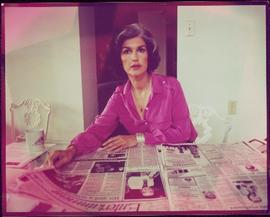File consists of proceedings and drafts of a presentation of "Science lessons for everyone? The writings of Catharine Parr Traill, 1802-1899."
Yoho National Park
Postcard depicts Cathedral Mountain on the Canadian Pacific Railway.
Postcard depicts Cathedral Mountain.
Postcard depicts Cathedral Mountain viewed from a spiral tunnel in the Canadian Rockies.
Postcard depicts Cathedral Mountain viewed from a tunnel in the Canadian Rockies.
Postcard depicts Cathedral Mountain near Field, BC.
Postcard depicts Cathedral Mountain near Field, BC.
Group of mountain climbers relaxing at the summit, Yoho National Park
Postcard depicts Cathedral Mountain viewed from a spiral tunnel in the Canadian Rockies.
Postcard depicts Cathedral Mountain. A CPR train was climbing the Kicking Horse Pass to the spiral tunnels in the Canadian Rockies.
Item is a reproduction of a report by Grant Hazelwood entitled "Cathedral Provincial Park Horse Trip Report - September 18-22, 1979".
Image depicts a Catholic Church in Stewart, B.C.
Image depicts a Catholic church at an unknown location.
Photograph depicts the catholic church at Cobble Hill on Shawnigan Lake.
Image depicts the Catholic Church in Penny, B.C.
Photograph depicts Catholic church, with rectory on its left, and First United Church behind. A wood boardwalk crosses midground, and a man can be seen riding a bicycle near church. Power lines and rough cleared land in foreground, hills and mountains in background. Handwritten annotation on recto of photograph: "Church in Rupert."
File consists of notes, clippings, and reproductions relating to Catholic churches in Prince George. File consists of material on the Sacred Heart Catholic Church at 887 Patricia Boulevard in Prince George; St. Fredricks Catholic Church in Giscome; and St. Joseph's Chapel at 1088 Gillett Street in Prince George. File predominantly includes printed photographs from The Exploration Place Museum database depicting various catholic churches in Prince George; and "St Joseph's Church" printed email from the Prince George Diocese Archives to Kent Sedgwick (17 Mar. 2010). Also includes photographs depicting a house at the address 1705 Fir Street in Prince George (2006).
Two people exploring the riparian shoreline along the Crooked River? Crooked River Provincial Park?
Takla Lake, Northern British Columbia
Photograph depicts a cattle barn of the Douglas Lake Ranch.
Photograph depicts a cattle dock about 1/4 mile west of the former site of the Haney CPR depot. To the left and west of the dock is a meat processing plant which used to use the dock but does not anymore. The view is looking northeast.
Photograph depicts cows and calves walking on gravel beside paved road. Field and tree-covered hills can be seen in background. Handwritten annotation on recto of mounted slide reads: "Spring in Lejak [sic]".
Photograph depicts a cattle shed located 3 miles east of Pavilion Lake, which is 15 miles northeast of Lillooet. It may have been a settler's cabin at one time.
Photograph depicts a cattle shelter/ barn at the head of Nicola Lake, 20 miles east of Merritt, near the Douglas Lake road turnoff.
Various organic debris caught in web
File contains slides depicting a caving group in various places in West Virgina, USA.
Photograph depicts Cayla Runka, Gary Runka, and Shaundehl Runka.
Image depicts Cayoosh Creek.
Image depicts Cayoosh Creek from a bridge in Cayoosh Valley.
Image depicts a bridge over Cayoosh Creek.
Image depicts a view of the scenery surrounding Cayoosh Creek.
Image depicts a view of the scenery surrounding Cayoosh Creek.
Image depicts a view of the scenery surrounding Cayoosh Creek.
Photograph depicts a horseback rider crossing Cayoosh Creek at a log bridge near Lillooet.
Image depicts a view of Cayoosh Valley.
Image depicts a view of Cayoosh Valley. Cayoosh Creek is visible in the bottom left corner of the image.
Image depicts Cayoosh Valley.
Image depicts Cayoosh Valley.
Image depicts a mountain side in Cayoosh Valley.
Image depicts a road in Cayoosh Valley.
Audio recording is of an CKPG-CBC affiliate recording at the Supreme Court in Prince George regarding the 60th anniversary of Judge J.O. Wilson being called to bar.
Audiocassette Summary
Scope and Content:
- CKPG-CBC affiliate recording at the Supreme Court in Prince George
- Justice Harold McInnis talks about Judge Wilson’s achievements and his career On the 60th Anniversary of his being called to the bar
- Other members of the Supreme Court congratulate him on his anniversary including Judge McInnis & Judge Stewart
- Judge Wilson recalls his early years practicing law
Item is a recording of an audio segment from CBC Radio in which a documentary update is provided on the inquest of Coreen Thomas.
Audiocassette Summary
Scope and Content:
- Update on the case of deceased Coreen Gay Thomas
- July 3, 1976 Coreen Thomas is struck and killed by a car walking out to the Stoney Creek Reserve
- Police Report blamed Coreen for causing the accident saying that she was involved in a game of chicken
- The Driver of the car, Mr. Redekopp, had a high blood alcohol content but was not blamed for the crash
- Indians claimed that they were frequently harassed on the road by white motorists
- An inquest occurred and focused on relations between Indians and Whites
- Redekopp, coroner, police detachment, federal department of Indian affairs all seemed to be on trial
- Vanderhoof residents state media coverage is sensational with Vanderhoof unfairly labeled as “the most racially troubled town in Canada”
- Some see problem as due to lack of activities for young people in small communities
- Stoney Creek Indians live in intolerable conditions
- Interview with Stoney Creek Reserve resident regarding sanitation problems; lack of proper sewage system; cases of tuberculosis; high rate of unemployment; she states DIA should be responsible and should come up with a solution
- Problem with the perception of an alcoholic society;
- Archie Patrick, FN leader talks about the prejudice, harassment and racism found in Vanderhoof and other Northern communities towards Native People
- Good things could come out of this inquest – Vanderhoof residents should learn about poor living conditions at Stoney Creek
- Reporter provides update on the inquest; that local Police were accused of intimidating the witnesses
- Coreen Thomas’ death was unnatural but accidental
- Redekopp was negligible because vehicle was going too fast
- Segment of interview with Harry Rankin on the Thomas’ inquest; questions on the state of fairness of the inquest; and the state of white-native relations in northern BC
- Inquest Findings: Measures that should be put into place: Upgrade emergency system in the area, no person be placed in morgue before death certificate is in issue, get resident doctor for hospital, breathalyzers taken as soon as is legally permitted, RCMP officers be encouraged to have parent or guarding present when questioning young people as witnesses, Stoney Creek Band Council and Vanderhoof Council work to establish a Friendship Centre
Documentary ends with interview of Sophie Thomas on need for a change in white-native relations – and ends with excerpt of music from the Vanderhoof ‘pioneer’ song.
End of Tape
Handwritten annotation on verso reads: “Summer / 80, S.F.U. + new life, first Jeans -”
Handwritten annotation on verso reads: “CBC Time”.
Audio cassette contains recorded a audio segment from the CBC Radio program, Daybreak of broadcaster Alison Payne interviewing Bridget Moran on the recent publication of Stoney Creek Woman.
Audiocassette Summary
Context: The recording is a segment from the CBC Radio program, Daybreak of broadcaster Alison Payne interviewing Bridget Moran on the recent publication of Stoney Creek Woman.
Scope and Content: Alison asks Bridget to explain why she is labeled an ‘activist.’ Bridget recalls it comes from her public conflict as a social worker in 1964 when she criticized the WAC Bennett government of its lack of adequate services for foster children and welfare families. And that it was intensified by her open conflict in the BC Legislature in 1972 with the Minister of Welfare Phil Gaglardi, as Bridget, acting as a liaison for the Association of Social Workers and low income groups, criticized the government’s proposed passing of Bill 49 to amend the Social Assistance Act. (The Bill would, if passed, extinguish the right of appeal by welfare recipients if refused the right to services). Bridget recalls that because of the ‘noise in the gallery’ she made she was tossed out of the BC Legislature.
Alison asks Bridget about the book Stoney Creek Woman and why she felt the need to write it. Bridget explains she needed to write the book as she had felt ‘guilty’ about the plight of people on reserves her entire life – and refers to an incident in the 1950s when she had brought her mother Rose Anne Drugan to the Stoney Creek Reserve and revealed to her the plight of poor women on the reserve. Her mother made her promise to assist these women and Bridget states the book was a way to do this. The book about Mary John is a story of a “typical life” of people living on reserves. That it describes the nomadic lifestyle being changed to one of the ‘shock of the residential school’ and the ‘cultural genocide’ that followed. Bridget notes that it was Mary John who realized that Native People would need to speak for themselves to bring about social change.
Bridget speaks about her close relationship with Mary John; Bridget praises her work in trying to change the plight of her people on the reserve for the better and that it became a significant cause for Mary John after the death of Coreen Thomas. Bridget describes Mary John as a woman “dedicated to the world of emotions”
Alison notes at the end of the interview that the launch of the new book is to be held November 25, 1988 at Mosquito Books in Prince George.
End of interview
Audio cassette contains recorded audio interviews with Bridget Moran and Barbara Whittington on a CBC Radio program regarding the Judge Gove inquiry.
Audiocassette Summary
Context: The recording is a segment from a CBC Radio program with broadcaster Mark [Forsythe?] interviewing Barbara Whittington, professor of Social Work at the University of Victoria [on the telephone] and former social worker Bridget Moran on the telephone from Prince George. They are being interviewed about the recent report released by Judge Gove into the case of the death of a Metis child ‘Matthew’ [Vaudreuil]. The interview focuses on the need for reassessment of social workers and contract workers training and social work education in British Columbia to be coordinated by educators and the Ministry.
Scope and Content: Recording starts with interview in progress – Barbara is answering question by Mark on the findings of the Gove inquiry- that the judge captured the “sadness” of Matthews’ death in the report.
Bridget is then asked by Mark her views on the Inquiry’s report. She states that she didn’t have any problems with what the judge said – but that there is nothing experimental being done here. She notes however that no specific mention is made of the fact that Matthew was a Metis child in a poor family – and that this should have been addressed in the report and findings. Bridget refers to the fact that somehow ‘social workers got the wrong message’ – and refers to her work experience as a social worker that if children were seen at risk in a home then there were removed from their home.
Mark questions Barbara on how the inquiry may impact the teaching of social work. Barbara states she doesn’t’ think it will affect the teaching; and that the report had positive comments on the social work program at UVic – and refers to the working of a ‘decentralized model’ of work. However she notes that a Bachelor in Social Work needs to be seen as a ‘entry point’ only – and that comprehensive training between the University and Ministry [of Social Work] is needed.
Discussion of social worker salary; burnout; and the issue of utilizing contract workers is discussed. Bridget notes that she did some research into this 2 or 3 years ago – and that of the 2000-3000 social workers in BC – there was another 10,000 contract workers doing work ‘that don’t know what they’re doing’ – uneducated workers – dealing with the assessment of potential children at risk.
Barbara agrees that many are not well trained and not well supported and that a coordinated effort with the Ministry is needed so that burnout is addressed and that social workers get the support needed.
Barbara concludes that the report should have addressed the issue of contract workers more than it did. She also notes that it should have addressed the need for First Nations community training in social work
– and notes that there are many First Nations community members ‘ready to go’ with this training. Bridget agrees that this issue was not adequately addressed – and notes that about 60% of children in foster homes are aboriginal. She notes that if we ‘fail a person in one generation’ [as was Matthew’s mother] then we ‘fail children in the next generation’. Barbara agrees.
Mark thanks them both –
End of interview
Audio cassette contains recorded audio interviews from a CBC Radio program interviewing Bridget Moran in the CBC Prince George studio on the recent publication of Justa.
Audiocassette Summary
Context: The recording is a segment from a CBC Radio program with broadcaster Mark [Forsythe?] interviewing Bridget Moran in the CBC Prince George studio on the recent publication of Justa. Mark first speaks to Justa by telephone asking him why he wanted his story told.
Scope and Content: Mark notes that Bridget Moran has just published a new book about the life of Justa Monk, entitled Justa: A First Nations Leader. Before speaking to Bridget, he speaks to Justa by telephone and asks him why he wanted his story told.
Justa says he wanted to tell people about the story of his life but also about the hardships of his people; for example he notes the transportation in the early years was difficult and that it took 21 hours by horse to travel from Tachie to Fort St. James. Also he says that what had happened to him [killing his brother] changed his life. He points out that in particular the Elders wanted him to tell his story. [Mark thanks Justa and the interview ends]
Mark then introduces Bridget Moran and asks her to comment on why she decided to write the book. Bridget first notes that she had heard about Justa’s life while writing the story of Mary John and that many people had suggested that she should write a book about his life as well. Although she had seen him at community events (potlatches) she was not introduced to him until November 1991. At that time he introduced himself and asked her to write his story – because he believed that it is possible to make amends for a bad life.
Bridget goes on to describe the circumstances leading to Justa killing his brother in a fight and that alcohol had been a factor. Justa had contemplated suicide.
Bridget then explains the setting of where Justa lived at Portage on Stuart Lake, 150 miles from Prince George. She notes that in many ways it was a very traditional life, totally dependent on the land. She says that Justa felt it was important in telling his story to tell native youth of ‘what they had – and what they had lost’.
Bridget then tells how Justa had been sent to a residential school at the age of 10 and that when he arriving the priest & nun took away his clothes. When he asks why – in Carrier – the only language he spoke – he was hit by the priest.
Bridget then talks about the structure of the book and notes that “what I was really doing was oral history.” She notes that she starting out interviewing him first because she notes she didn’t know him very well – but that it progress she then just talked with him. Bridget comments that Justa is a ‘real communicator’ and uses body language well – and she noted that he could remember details and emotions very well which gives a “sense of immediacy” to his story.
Mark asks Bridget to explain how Justa went from killing his brother – to becoming a leader of his people. Bridget notes that although it was felt he acted in self-defense, that Justa felt that he had to do penance for what he did. He was charged with manslaughter and served his time in a Forestry camp. After that he decided to go back to school and finish his education in Dawson Creek. He then decided to come back to Tachie to ‘make peace with his people’ and that the Elders forgave him and accepted him.
Justa then went on to work in the Band Office, then as Manager, then as Chief and in 1990 was elected as the Chief of the Carrier Sekani Tribal Council.
Bridget states that Justa’s legacy for native youth in particular – is that you can overcome hardships and turn your life around. Bridget notes that instead of drugs and alcohol that youths should look to their culture, language and Elders to help them.
Bridget then notes that her hope is to now hold workshops to help First Nations document their own history. To show them how they can take ‘raw material that I start work with’ and ‘work it up into a readable story.’ She hopes to hold workshops with Bands so that they can ‘do it for themselves’ – particularly as so many of the Elders are sick and dying and won’t be around to tell their stories.
Mark thanks Bridget –
End of interview
